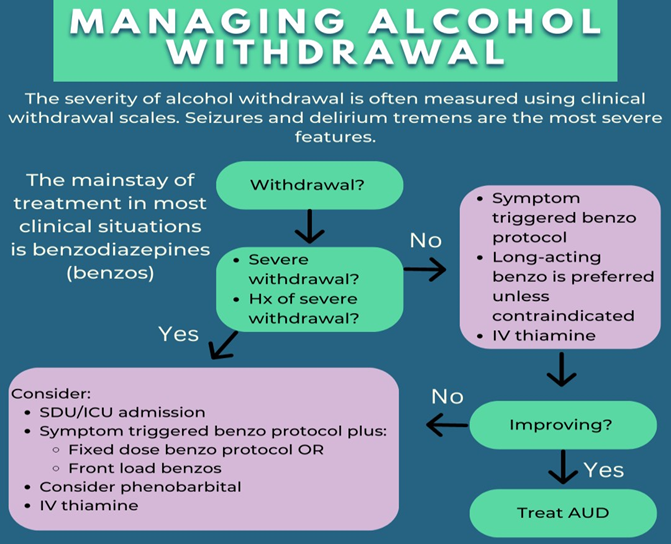A nurse is caring for a client who begins showing signs of alcohol withdrawal delirium. Which of the following medications should the nurse administer?
Methadone
Acamprosate
Disulfiram
Lorazepam
The Correct Answer is D
A. Methadone is an opioid agonist primarily used for the management of opioid dependence and chronic pain. It is not indicated for the treatment of alcohol withdrawal or delirium.
B. Acamprosate is a medication used to support abstinence in individuals who have recently stopped drinking alcohol. It is not typically used to manage acute alcohol withdrawal symptoms such as delirium tremens.
C. Disulfiram is a medication used as an aversive therapy to deter alcohol consumption by causing unpleasant reactions (e.g., flushing, nausea, vomiting) when alcohol is ingested. It is not indicated for the treatment of alcohol withdrawal or delirium.
D. Lorazepam is a benzodiazepine commonly used to manage alcohol withdrawal symptoms, including delirium tremens. It acts by enhancing the inhibitory effects of gamma- aminobutyric acid (GABA) in the central nervous system, thereby reducing the symptoms of alcohol withdrawal such as seizures.

Nursing Test Bank
Naxlex Comprehensive Predictor Exams
Related Questions
Correct Answer is A
Explanation
A. Tyramine is found in various foods and its levels increase when food is aged or fermented. Avocados, especially if they are overripe, can contain higher levels of tyramine compared to the other options listed. It is important for individuals taking MAOIs to manage their intake of tyramine-rich foods to avoid adverse reactions.
B. 2% milk does not contain significant levels of tyramine compared to aged or fermented foods like avocadoes.
C. Sliced apples do not contain significant levels of tyramine compared to aged or fermented foods like avocadoes.
D. Celery sticks do not contain significant levels of tyramine compared to aged or fermented foods like avocadoes.
Correct Answer is A
Explanation
A. Clozapine is an antipsychotic medication commonly used to treat schizophrenia.
Reduction in auditory hallucinations is a positive therapeutic outcome indicating the medication's efficacy in managing psychotic symptoms.
B. While clozapine may have antiepileptic properties, it's primarily used for its antipsychotic effects rather than controlling seizures.
C. Weight gain is a common side effect of clozapine rather than an indicator of therapeutic effect.
D. Clozapine is associated with the potential for agranulocytosis, a severe adverse effect characterized by a decreased white blood cell count, but this is not a measure of therapeutic effect.
Whether you are a student looking to ace your exams or a practicing nurse seeking to enhance your expertise , our nursing education contents will empower you with the confidence and competence to make a difference in the lives of patients and become a respected leader in the healthcare field.
Visit Naxlex, invest in your future and unlock endless possibilities with our unparalleled nursing education contents today
Report Wrong Answer on the Current Question
Do you disagree with the answer? If yes, what is your expected answer? Explain.
Kindly be descriptive with the issue you are facing.
